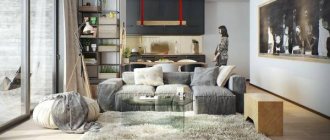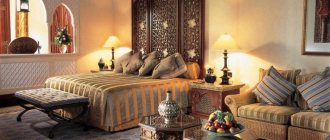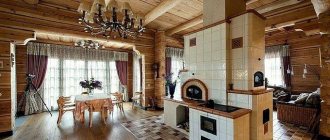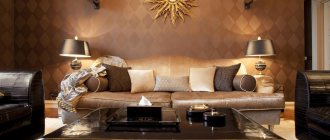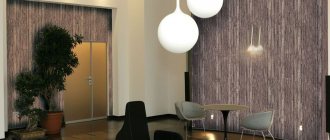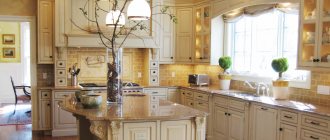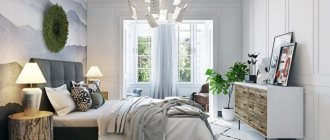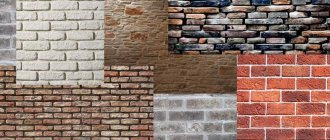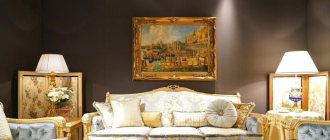What is brutal interior and brutalist style
The birthplace of brutalism in interiors is considered to be Great Britain, and its creators are Alison and Peter Smithson, who own the expression béton brut, which literally means “raw concrete.”
The main feature of brutalism is considered to be an urban look, which is probably why truly masculine interiors are associated with the loft style - minimalistic, demonstrably uncomfortable and in some ways even rude.
All these characteristics can be considered brutality. Below are the techniques that allow you to achieve this effect in the interior.
Choosing a color for the brutalist style
Brutalism does not welcome warm and bright colors. Only cool shades set the character of the direction.
White, shades of gray, and desaturated blue are most often found in brutal interiors. Choosing monochrome will be the best solution; here you will definitely not go wrong in choosing a suitable palette.
Cold concrete is rarely combined with wood, which brings a completely different mood to the room. If there are wooden structures (beams, panels, floors), they are usually painted white or gray.
Brick can also be painted, but due to its rigid appearance, all the neutral shades of the material are often present in the design. Sometimes, to give a powerful look, wall areas are painted dark red, which adds some volume to part of the room.
Features of the brutalist style:
- Functionality and minimalism. The premises are equipped only with the most necessary things. Nothing superfluous, both in finishing and in decor.
- Simplicity. The brutalist style does not accept pretentiousness and luxury. The design should be simple, the furniture should be in strict lines; no high cost, pomp or attractive gizmos.
- Massiveness. Large forms and massive structures emphasize the industrial appearance of the room, which has more of an external appearance of buildings than an internal one.
- Raw material. Raw concrete walls, stone and brick highlight the rugged style.
The exposed surfaces of concrete, stone, and brick are not decorated, but only varnished for reliability and long service life. The floor is covered with discreet carpets. The windows are dispensed with without drapery; but it happens that they look good with light steel-colored curtains.
Who is the Neo-Brutalist style interior recommended for?
• Ascetics and rationalists who value simplicity and clarity.
• Fanatics of cleanliness and bachelors who do not want to spend extra time on cleaning. In austere interiors in the neo-brutalism style, devoid of decor and small details that collect dust, general cleaning will take half an hour.
• Uncompromising purists who despise sentimentality and decoration.
- 1 of 1
On the picture:
Elements of neo-brutalism are especially often used in the design of lofts.
Finishes and materials
Open structures. Based on the principle of “honesty of materials”, which brutalism insists on, decorative coatings are the same or not much different from the material of the structures themselves. Concrete walls, beams and ceilings, brick walls are not hidden under layers of drywall, but they can be coated with clear varnish.
Wooden frames, rafters and steps of stairs, metal frames emphasize the harsh nature of the interior. Glass and sheet metal elements help to emphasize the juxtaposition of textures (this is how an individual image is built): for example, one partition is made of frosted glass, and the wall next to it shows rough brickwork.
New high-tech materials. For example, plywood with a special waterproof impregnation can be used to cover walls, floors and ceilings in a bathroom. Optimal floor coverings include microcement, porcelain stoneware, self-leveling flooring, and solid boards.
- 1 of 3
On the picture:
Microcement, porcelain stoneware, self-leveling flooring are welcome as floor coverings in neo-brutalist style interiors, and concrete walls are often not faced with another material, but simply varnished.
Brutal style finishing
Most often, to create such a design, massive natural stone with a relief structure, metal elements, and wood with a minimum of processing are used. Concrete is often used in combination with glass and metal; leather and coarse fabric will help diversify the decor. To avoid “crowding” the room with furniture, it is preferable to use options with legs - this way there will be free space below, which will visually make the decor less cumbersome.
In general, furniture is selected to fit the overall concept. It is important that it has strict geometry and harmoniously combines with the walls. “Secret” wardrobes and metal shelving look good.
Furniture
Furniture should correspond to the general concept of style, be simple and functional. When choosing a setting, first of all, they are guided by the principle of asceticism. The interior should not contain unnecessary details, so any thing should perform a specific function.
When choosing, you should give preference to natural textures and natural materials. Brutalism uses strict geometric shapes. Built-in wardrobes and transformable furniture would look appropriate in the interior.
view album in new window
All furnishings must match the style, be simple and functional. One of the main principles of brutalism is to limit the use of furniture and accessories. All of them have a rough texture and a simple geometric shape. The use of high quality equipment is allowed in the interior. Modern equipment must carry a functional load. The furnishings should not contain items that are not used by the owners of the premises.
Preference should be given to upholstery materials such as leather or fabric. Solid wooden furniture also looks organic in the interior. Often its surface is artificially aged so that it organically fits into the style concept. The furnishings must include upholstered furniture. This could be a leather sofa or rocking chairs. It is important that they are comfortable and contribute to a comfortable rest.
Brutalism style in the interior - design photo
Interior design in the spirit of Brutalism should be based on the work of a limited range of shapes, colors and other means of expression. Such spaces often lack decorative motifs, are raw and simple in expression and economical in color. The pieces are simple shapes with a unique geometric beauty and a combination of different levels of shade while maintaining the same color.
In any case, remember that the furnishings of the apartment absolutely accurately show the character of the owner, his emotional impulses. It would be stupid to create an interior design that contradicts our desires.
In such a situation, not peace and harmony will reign in our home, but a constant struggle between the internal sense of self and the external environment. That’s why it’s worth thinking very carefully about what style will contribute to your comfort, maintaining a sense of security and comfort. Who knows... Perhaps your choice is a marine style in the interior...
Tags
interior styles style style brutalism
Characteristics
The widespread popularity of brutalism allowed the style to go beyond architecture, creating, among other things, an independent direction in the field of interior design. As a result, the world saw a masculine style that does not hide, but, on the contrary, deliberately demonstrates the natural texture of materials, evoking associations with prehistoric times and caves in the rocks.
Brutalism, as an interior style, is characterized by the following features:
- simple rectangular shapes;
- rigor and clarity of lines;
- rough naturalness of surfaces;
- spacious premises;
- functionality;
- sculpturality;
- thoroughness.
Despite the controversial attitude of society towards the movement in question, brutalism has still won many admirers who prefer natural forms and textures rather than decorative drapery.
In interiors made in the brutalist style, all furnishings perform strictly defined tasks and are located in a specific place. This ensures a given order and maximum free space.
What furniture is suitable for brutal style?
The brutalist style is gaining more and more supporters, perhaps because many are tired of false pomp and flashy colors. After all, you want something real and natural.
Furniture and household items here are also characterized by simplicity, roughness and real functionality. There is nothing accidental here. Limiting the amount of furniture and accessories is one of the basic principles of style.
The equipment that fills the space must be of the highest quality. The furniture is devoid of additional decoration, but the very shape of each piece of furniture and equipment becomes a decoration - a geometric accent of the design.
Today in specialized interior stores we can find a good selection of furniture, equipment, lighting fixtures or interior accessories needed for our tasks.
But while you don't have to worry about getting something fancy and designer, you should try purchasing a few interesting accents that will add personality to your home.
Furniture and other equipment in this type of premises have single-color surfaces in natural shades. The most common colors are cool colors such as grey, black, navy and shades of brown.
Lighting and interior details
Lighting plays an important role in brutalist interiors. Designer lamps are not only a functional element of the interior, but also very often one of the few decorations in an apartment or house.
Straight lines are most often used. Style requires lightness in forms and open spaces. Of course, the simplicity of the form does not necessarily translate into its banality.
An interesting accent piece can be a bold lamp, an armchair, or even small accessories such as a prominent kitchen faucet, interesting bathroom fixtures, or a vibrant painting. Thanks to their simplicity in form, such details play a key role in building the character of the interior.
Color, decor and lighting
Traditionally for brutalism, designers use natural light tones and halftones, which bring freshness and attractiveness to a rather rough interior without violating the fundamentals and principles of the style.
Today, a natural color palette is still encouraged. However, modern trends allow one surface to be highlighted with rich and/or bright colors, which gives the space volume.
A characteristic feature of brutalism is the maximum possible natural illumination of the indoor space. Thus, a natural decor is created in the form of chiaroscuro and glare of sunlight, providing original effects.
As for electrical appliances, the rules here are dictated by minimalism. Chandeliers, lamps and lamps are selected so that there is not even a hint of chic and extravagance. As a rule, lighting technology in the brutalist style is distinguished by regular shapes, clear edges and right angles. An alternative could be products in the form of plates or balls.
At the same time, the use of lamps of different shapes and combined materials is highly encouraged, which make it possible to diversify or complement the interior. Lighting equipment suspended on wires or chains fit organically into the given style.
If we talk about the decor of rooms in the brutalist style, then here you will not find an abundance of paintings, photographs in frames, figurines, etc. The style does not include decorating walls and ceilings, hinting that they are beautiful even without accessories.
A minimum of decor and non-functional things, a natural color palette and lighting, as well as a maximum of free space - this is the concept of brutalism.
Brutalism style furniture selection
Brutal furniture includes a rough-shaped sofa on a wooden frame; wooden chairs with a straight back; tables of simple geometric shapes. Cabinets and cabinets acquire dark or nondescript shades with metal inserts.
The beds are not decorated with forged parts or carvings, but are rigid models with straight legs. In general, furniture should be massive to show the severity of the style.
You will hardly see anything from accessories; Brutalism has no creative component. It is aimed at elements that will not catch the eye, but will only be harmoniously lost in the design.
Unique decor
Brutalism does not tolerate decoration. Textiles are kept to a minimum - lint-free carpet, no curtains on the windows. Blinds are possible.
A characteristic accessory of the direction is a floor lamp hanging in an arc above a sofa or table. Such details emphasize large spaces. Colors: metallic, black, white.
The walls are diluted with conceptual painting - expressionism, fauvism, abstraction. Wooden or metal panels are appropriate.
Stairs in brutalism are like a separate form of art. Concrete or wood, frameless or monolithic. Echoing industrial or high-tech trends.
The concept of brutalism in architecture and interior
What attracts us most to our own home? Most likely, a feeling of comfort and calm. But a lot in our home is created by interior design. For each person, the feeling of relaxation and serenity will manifest itself in a different environment. For some, the tenderness of romanticism will be ideal, for others the unusualness of modernism, and for others the brightness and radiance of eclecticism will be ideal.
But it is worth saying that interior design also has such a direction as brutalism. This word is consonant with brutality, a concept that we are accustomed to consider as a human trait. But our home can also match our character. This is how different kinds of styles appear, under the influence of human characters and temperaments.
Related publications
Gold paint for decoration: compatibility testing
17/04/2020
White brick in the interior of our house
05/11/2019
Interior design trends: what will be fashionable in the near future?
18/10/2019
Stained glass in the interior: photo and meaning in modern design
14/09/2019
Let's return to our brutalism. As a trend in architecture, it appeared in the late forties and early fifties of the twentieth century and continues to successfully march across cities and continents throughout the planet.
… “The Brutalism style (from the Latin “brutus” - heavy or rough) traces its history back to the United Kingdom of Great Britain, from the late 40s of the 20th century”...
If we look at this concept more closely and look at the origins of the style, then brutalism is an architectural movement originating from modernism, which developed in the fifties of the last century until the mid-1970s. The term itself comes from the French word “ bé ton brut ” the British architectural critic Reyner Banham was the first to define the concept of cruelty, which already allowed us to talk about a new style.
Rigidity and roughness quickly gained popularity among architects and designers in many countries around the world and was perceived as a reaction of the younger generation to the lightness and optimism of the architecture of the 1930s and 1940s.
But what’s interesting is that recently, rigidity has again become a popular solution when choosing interior architecture and design, as well as architecture in general.


